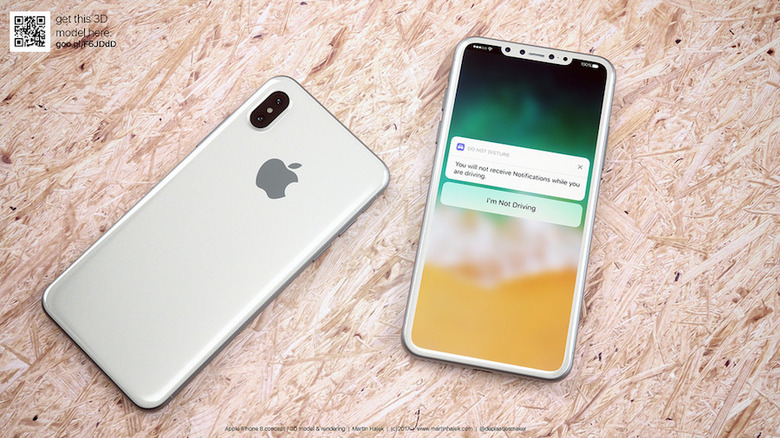A Closer Look At The iPhone 8's Facial Recognition Feature
Regardless of whether or not the iPhone 8 will feature Touch ID, it's all but guaranteed that the device will feature facial recognition technology. Over the past few weeks and months, word that the iPhone 8 will incorporate facial recognition has been corroborated by a number of credible sources, not to mention an endless stream of iPhone 8 parts leaks featuring discernible cutouts for additional camera sensors on the front panel of the device.
That being the case, we thought it would be a good time to take a closer look at what the iPhone 8's facial recognition system will likely bring to the table, from both a performance and security perspective. While Apple tends to keep upcoming technologies and features under lock and key, its upcoming facial recognition software will likely be based on technology it acquired when it purchased an Israeli machine learning company called Realface earlier this year. Consequently, a close examination of Realface's cutting edge technology can provide us with a number of significant clues as to what we can expect out of the highly anticipated iPhone 8.
While facial recognition software in and of itself isn't anything new, Realface's implementation is completely novel and perhaps more advanced than anything else available in the mobile space. Whereas the facial recognition software you might find on a Samsung Galaxy flagship relies upon a 2D map of a person's face — which makes it relatively easy to fool — Realface's technology creates a 3D representation of a person's face for an added layer of accuracy and security. On its now defunct website, the company boasted that its software — which it touted as "anti-spoof face recognition" — can deliver accurate results incredibly quickly thanks to its proprietary algorithms and deep learning methods.
The company also claims that its software can recognize faces with an impressive 99.67% success rate, a figure which is actually higher than the 97.5% success rate most humans are capable of when it comes to recognizing faces.
"Our technology provides our customers and end-users with the highest level of authentication and security available on all platforms," the company said not too long ago. "We have proprietary IP in the field of frictionless face recognition and effective learnings from facial features."
Further, Realface's technology is said to be so sophisticated that it can filter out photos, videos and even sculptures designed with the express purpose of tricking the software.
A demonstration of the software's anti-spoofing capability can be seen below. The pertinent portion of the video begins at about the 13:50 mark and illustrates how even high quality photos and videos can't fool the technology.
And in case you were wondering, the software is so precise that it can also distinguish between pairs of identical twins.
A 2016 write-up on the company from the Hebrew-language Gadgety reads in part:
The second challenge, and the coolest one to note, is the twin challenge: the system needs to distinguish between two identical twins and know when each is presented to her. Realface, in a series of experiments that examined pairs of twins, was able to distinguish between the different brothers and even determined who stands before her at every stage.
Now what happens when a person's appearance changes over time? After all, individuals routinely alter their appearance in a myriad of ways. Impressively, this is where the machine learning aspect of the software comes into play.
During an October 2016 talk, Realface CTO Gidi Littwin — who currently works at Apple as a machine learning engineer — explained how this problem is addressed:
Another design consideration is the fact that face recognition in the authentication context, you only need to keep track of one individual; but you need to keep track of changes in his appearance over time. People shave, wear makeup, wear their hair differently. So, we designed a new learning method that's called personalized recognition that enables the system to evolve over time and essentially get to know you.
All that being said, Realface's facial recognition technology is said to be so advanced that it can reliably be used for biometric authentication and even as a means to authorize secure financial transactions. Indeed, Littwin during the aforementioned lecture made a point of noting that the technology was designed with the intention of meeting the stringent security requirements of financial institutions.
A video demo of RealFace's technology in action can be seen below. You'll note that the setup process is exceptionally quick and only requires one photo to be taken in order for a unique identifier to be created.
As far as security is concerned, Realface's technology does not store any raw image files, with Gadgety adding:
All information entered into the system is converted at the end of the day into numbers and variables and nothing else. Even worse, raw information can not be reproduced internally even if it reaches the wrong hands. Above all, the entire data is stored locally on the device where identification is performed, similar to the way fingerprint sensors operate on Apple or Android devices.
All in all, this sounds like a great feature, but it's still hard to envision facial recognition replacing Touch ID entirely given certain use-case scenarios where a user isn't looking directly at the screen. Replacing Touch ID would also make using Apple Pay decidedly more awkward. The good news is that we won't have to wait too much longer to see what the iPhone 8 has in store for us. If all goes according to plan, we can expect Apple to unveil the iPhone 8 at a special media event in just about two months.
